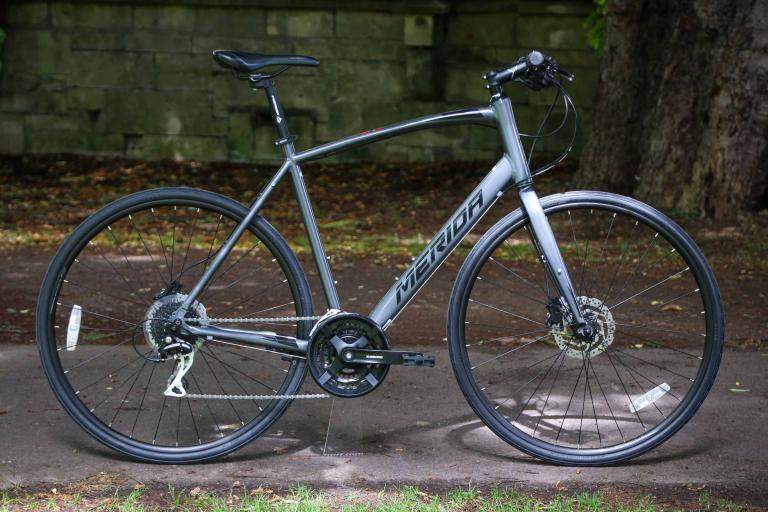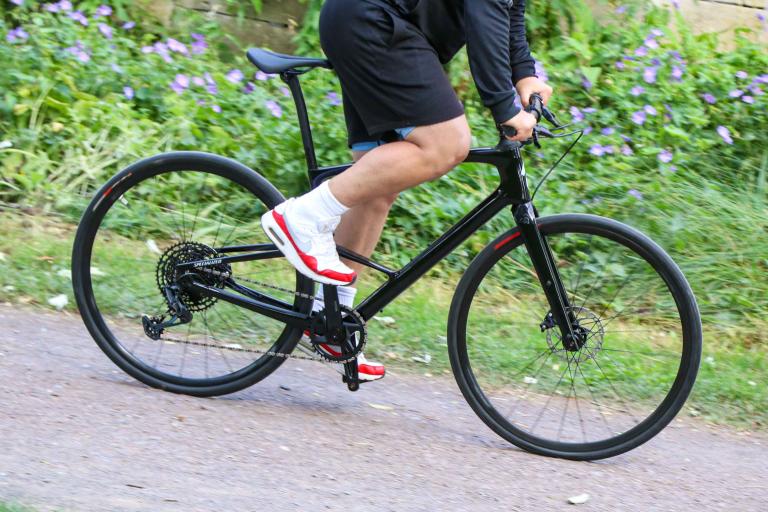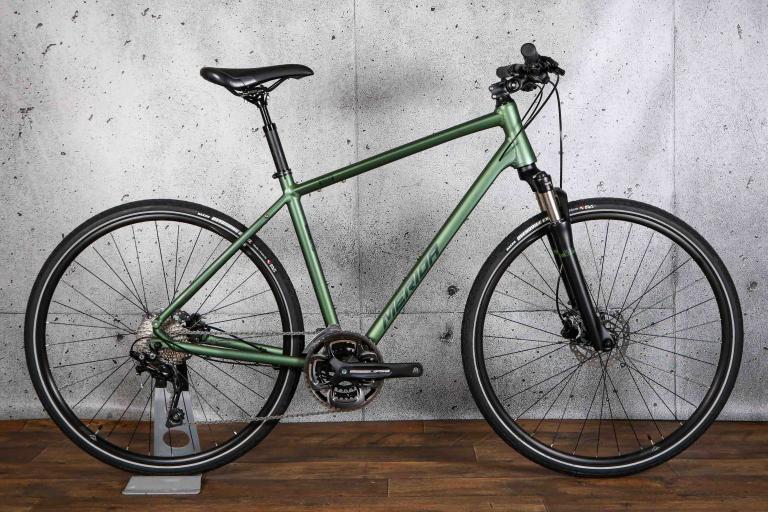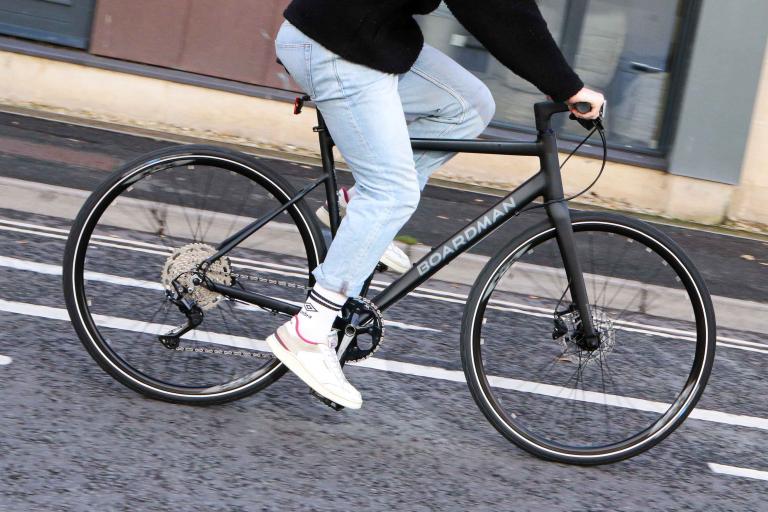- News
- Reviews
- Bikes
- Accessories
- Accessories - misc
- Computer mounts
- Bags
- Bar ends
- Bike bags & cases
- Bottle cages
- Bottles
- Cameras
- Car racks
- Child seats
- Computers
- Glasses
- GPS units
- Helmets
- Lights - front
- Lights - rear
- Lights - sets
- Locks
- Mirrors
- Mudguards
- Racks
- Pumps & CO2 inflators
- Puncture kits
- Reflectives
- Smart watches
- Stands and racks
- Trailers
- Clothing
- Components
- Bar tape & grips
- Bottom brackets
- Brake & gear cables
- Brake & STI levers
- Brake pads & spares
- Brakes
- Cassettes & freewheels
- Chains
- Chainsets & chainrings
- Derailleurs - front
- Derailleurs - rear
- Forks
- Gear levers & shifters
- Groupsets
- Handlebars & extensions
- Headsets
- Hubs
- Inner tubes
- Pedals
- Quick releases & skewers
- Saddles
- Seatposts
- Stems
- Wheels
- Tyres
- Health, fitness and nutrition
- Tools and workshop
- Miscellaneous
- Cross country mountain bikes
- Tubeless valves
- Buyers Guides
- Features
- Forum
- Recommends
- Podcast
review
£1,179.00
VERDICT:
Not without its faults, but a decent electric mount for power seekers
Weight:
21,250g
Contact:
www.halfords.com
At road.cc every product is thoroughly tested for as long as it takes to get a proper insight into how well it works. Our reviewers are experienced cyclists that we trust to be objective. While we strive to ensure that opinions expressed are backed up by facts, reviews are by their nature an informed opinion, not a definitive verdict. We don't intentionally try to break anything (except locks) but we do try to look for weak points in any design. The overall score is not just an average of the other scores: it reflects both a product's function and value – with value determined by how a product compares with items of similar spec, quality, and price.
What the road.cc scores meanGood scores are more common than bad, because fortunately good products are more common than bad.
- Exceptional
- Excellent
- Very Good
- Good
- Quite good
- Average
- Not so good
- Poor
- Bad
- Appalling
The Urban Mover UM44S is a decent electric bike that will appeal to commuters and leisure cyclists who want, or need, a bit of a push along the way. The electrics perform well, it isn't overly heavy and the ride quality is pretty good. It isn't without its faults but electric bikes are getting better every year, and while this isn't the best we've seen it's a well thought out solution to the problem of adding power.
First things first: it's only fair to report that the bike you see here is our third test bike: The first suffered from a plug failure (there was a faulty batch, apparently) which stopped the motor from working. The second one was fine, until it randomly decided to power up as I was wheeling it out of the door, sending it on a ghost ride into the road, where it fell with the bars twisted round, pulling the wires out of the control unit. This type of accident shouldn't be possible with a pedelec bike, as you have to apply pressure to the pedals for the motor to kick in, which suggests a faulty controller. Anyway the third bike came, which was actually the first bike again, but with a new plug. And this time it has been perfectly behaved.
For your £1149 you get an Aluminium frame and suspension fork to house the power system, the heart of which is a 37v, 200W brushless hub motor in the rear wheel and a 9aH Panasonic Li-Ion battery which slots in behind the seat tube. The rest of the spec is nice and practical, with full mudguards, a chainguard and a rack included. The bikes on the Urban Mover website all have lights, tYou get a suspension seatpost and adjustable stem, and a Shimano Altus seven speed drivetrain. Tektro V brakes do the stopping, mated to levers that cut the power when you haul on the anchors. There's a nurse's lock which cleverly includes a short chain to better immobilise your bike when you're popping into the Post office, and a kickstand too, which you'll be grateful for. It's a pity that the price tag puts it out of range of most people on cycle to work schemes: most employers have a £1,000 limit.
The bike is a pedelec - it'll only supply power when you're pedalling, and it uses a torque sensor in the chainset to match your effort. This makes the pedal stroke a bit odd as there's play in the sensor between the cranks and the bottom bracket axle, but you soon get used to it and you can smooth your pedal stroke out to mostly eliminate it: the trick is not to try too hard. The power is applied evenly, quietly for the most part, and intelligently: riding along on the flat you'll barely notice you're being assisted at all. Until you switch the motor off. Sometimes on a slight downhill the motor can get a bit choppy as it can't decide whether to help you or not, and on slow uphill drags it starts to get a bit noisy, but most of the time it's excellent.
And is it powerful enough to make a difference? Yes, most definitely. The motor's as powerful as it's legally allowed to be, and while it wouldn't power me up some of Bath's climbs on its own it's certainly a big help. On the flat it makes cruising absolutely effortless, and the kick away from the lights in town is a bonus too, though there's always a slight lag as you wait for the motor to kick in. I've tested the bike with the biggest load I could reasonably manage: me, full panniers, a tagalong and a 4 year old child, up a steep hill. Normally that'd reduce me to a muggy crawl but on the Urban Mover I breezed up, barely breaking a sweat. Top marks on that front. If you struggle with the physical effort of cycling for whatever reason, there's no doubt that the Urban Mover can significantly reduce it for any given journey.
One of the telling tests of an electric bike is to ride it with the power off: you get a better understanding of whether it's actually a decent bike in its own right. Obviously at 21kg you're not going to get anywhere in a hurry but actually the UM44S is a perfectly serviceable hybrid. There's a bit of drag from the motor and the play in the torque sensor is a bit annoying, but if the battery did die you'd have a sporting chance of getting home, assuming home wasn't at the top of a big hill.
It's not all good news, of course. One thing that's very annoying is the power indicator: it's heavily influenced by the load on the motor, so when you're riding up a steep hill it will read empty, but when you stop at the top you'll suddenly have two bars of juice. The only way to find out the actual battery charge at any time is to stop pedalling to unload the motor, which isn't something you really want to do on a long drag uphill. Once you get used to the way the power meter works you can normally guess how much life is left, but you shouldn't really have to guess.
Other gripes are mainly just the usual stuff. For instance, why the suspension fork? Quite apart from the fact that cheap suspension forks aren't any good, this is an upright bike that'll be almost exclusively ridden on the road. You're not bearing much weight on the handlebars and the roughest terrain you're likely to encounter is a pothole, which the big air chambers of the tyres, the suspension seatpost (if it worked well, which it doesn't) and the chunky saddle will easily cope with. A bouncy fork just adds weight, complication and expense. ditch it, and the 'post for lighter rigid ones and spend the money on something else, like an upgraded transmission. The wheels could do with a bit of a revamp too: obviously they need to be strong but generally that seems to mean a heavy deep section alloy rim when a well-made standard one would be fine, and that's the case here. The Kenda tyres aren't much to write home about either.
Battery life is a big issue on these bikes as well - you need to be able to at least spend the day on your machine, however long your day is in terms of mileage. That way you can just keep the charger at home. Urban Mover claim the range of the UM44S is 49 miles, which around lumpy Bath with a 95kg pilot is somewhere in the realm of happy fantasy and an unhelpful number to bandy about. A svelte young lady traversing the fens with a tailwind might get that kind of mileage out of the bike, but round here about 15-20 miles is about your limit, less if you throw in a couple of real hills.
My commute home is up a hill that'd just about rate as a Cat 4 climb in the Tour: a 3km ascent that averages just under 5% and steepens to 12%. Down the hill into work and back up again in the evening is enough riding to get the battery to a point where I'm not confident it'd do another round trip, and that's only 6 miles of riding. Similar to the pressure ratings on mini pumps, I'd much rather see a realistic range figure that I could be happy I got somewhere close to, rather than being constantly disappointed.
Verdict
Overall I enjoyed riding the Urban Mover. It certainly comes into its own when you're cruising about in town, or there's a few lumps and bumps to negotiate. You wouldn't want to spend a day on it, and you wouldn't want to lug it up the stairs to your penthouse, but for a daily commute it's a comfortable, well specced machine that can get you where you're going with a bare minimum of effort. It's a pity that manufacturers still pander to the whims of their buyers by fitting suspension where it simply isn't needed, but on the plus side full mudguards, a rack and an integral lock are welcome additions. Check the bike's range over the terrain you'll be riding before you buy: don't assume it'll do the stated 49 miles in the highlands or on the Cornish coast. Or, for that matter, anywhere else.
road.cc test report
Make and model: Urban Mover UM44S Electric bike
Size tested: n/a
About the bike
State the frame and fork material and method of construction. List the components used to build up the bike.
High Power S type 37V high torque brushless motor
Panasonic 37V 9Ah Lithium Battery (2 year warranty)
Advanced City hybrid alloy step through or crossbar frame design
Lightweight – only 21.5kgs (with battery)
High impact Polycarbonate P chain guard
High impact polycarbonate chromed mudguards
26” MTB double rim alloy wheels
Telescopic front sport suspension system
Sprung suspension post/ Velo® gel saddle
Shimano Altus transmission
Tektro V brakes
Tell us what the bike is for, and who it's aimed at. What do the manufacturers say about it? How does that compare to your own feelings about the bike?
"Urban Mover is without doubt one the world's most innovative dedicated electric vehicle (EV) companies and is fast becoming one of the most respected brands in its sector.
"Urban Mover is not about marketing fads and theme invention just for arts sake. In all our products there is a real sense of purpose, practicality and usability. In our design, there is a purity and legitimacy to the process and a dogged sense of conviction to the finished product.
"Good design has longevity, and this is reflected in the core product that we offer our customers. The challenge is not just to maintain this value, but to continually improve designs based on our dealers and customers needs."
Frame and fork
Overall rating for frame and fork
7/10
Tell us about the build quality and finish of the frame and fork?
Welds are a bit untidy in places but no issues with integrity
Tell us about the materials used in the frame and fork?
Frame: Alloy
Fork: Suspension (Alloy/Steel)
How was the bike in terms of height and reach? How did it compare to other bikes of the same stated size?
It was fine for city riding under power, if it had been a standard hybrid I'd have needed another inch of seatpost
Riding the bike
Was the bike comfortable to ride? Tell us how you felt about the ride quality.
The bike's certainly comfortable, though there's a certain muddiness to the ride feel from the suspension elements
Did the bike feel stiff in the right places? Did any part of the bike feel too stiff or too flexible?
The frame was plenty stiff, the fork a bit flexy
How did the bike transfer power? Did it feel efficient?
Unpowered the torque sensor in the chainset makes the power transfer a bit vague
Was there any toe-clip overlap with the front wheel? If so, was it a problem?
A little, but it wasn't a problem
How would you describe the steering? Was it lively, neutral or unresponsive? Neutral
Tell us some more about the handling. How did the bike feel overall? Did it do particular things well or badly?
It's a comfortable cruiser and stable going downhill.
Which components had the most effect (good or bad) on the bike's comfort? would you recommend any changes?
The saddle was comfy for about 3 miles before it started to make itself known, I'd prefer something a little sportier. The suspension seatpost and fork weren't up to much, and the tyres were big but a bit dead feeling.
Which components had the most effect (good or bad) on the bike's stiffness? would you recommend any changes?
Ditch the suspension fork. and the seatpost. Spend the money on better rims and tyres, and a better groupset.
Which components had the most effect (good or bad) on the bike's efficiency? would you recommend any changes?
The fork was noticeably flexy and the torque sensor gave pedalling an odd feel
Rate the bike for efficiency of power transfer:
5/10
Unpowered it's pretty average
Rate the bike for acceleration:
8/10
Not light but you get a good kick from the motor
Rate the bike for sprinting:
2/10
Don't even try
Rate the bike for high speed stability:
8/10
Lots of gyroscopic force from those heavy wheels...
Rate the bike for cruising speed stability:
9/10
Best at 10-12mph
Rate the bike for low speed stability:
6/10
Not bad but a bit cumbersome
Rate the bike for flat cornering:
7/10
Not much weight on the front makes it a bit vague
Rate the bike for cornering on descents:
7/10
Better at speed so long as you don't want big direction changes
Rate the bike for climbing:
9/10
Motor power rules uphill
The drivetrain
Rate the drivetrain for performance:
5/10
Altus isn't the nicest to use
Rate the drivetrain for durability:
7/10
Should last okay, no problems in testing
Rate the drivetrain for weight:
6/10
Not heavy, not light either
Rate the drivetrain for value:
5/10
Could do better if the spend was rearranged a bit
Wheels and tyres
Rate the wheels and tyres for performance:
4/10
Heavier than necessary, tyres feel a bit dead
Rate the wheels and tyres for durability:
8/10
They ain't gonna break in a hurry
Rate the wheels and tyres for weight:
3/10
Very lardy, obviously a 200W motor doesn't help
Rate the wheels and tyres for comfort:
7/10
The big air chambers make up for the other wheel sins a bit
Rate the wheels and tyres for value:
5/10
Again, more spend on the wheels and less on needless suspension
Tell us some more about the wheels and tyres.Did they work well in the conditions you encountered? Would you change the wheels or tyres? If so, what for?
They worked okay, but they don't do the bike any favours. Better tyres would be the first change.
Controls
Rate the controls for performance:
6/10
Altus is easy to use, so's the Electric control though it's a bit flaky. Brakes are fine.
Rate the controls for durability:
7/10
Electric control works loose easily, but otherwise fine
Rate the controls for weight:
6/10
Middleweight gear all round
Rate the controls for comfort:
7/10
No problems on test
Rate the controls for value:
6/10
Not bad, the Altus shifter would be a candidate for upgrade
Your summary
Did you enjoy riding the bike? Yes
Would you consider buying the bike? No, it isn't for me right now
Would you recommend the bike to a friend? Yes, depending on their circumstances
About the tester
Age: 36 Height: 190cm Weight: 98kg
I usually ride: Schwinn Moab, urbanised with 700cs My best bike is: Trek 1.5 with upgrades
I've been riding for: 10-20 years I ride: Every day I would class myself as: Experienced
I regularly do the following types of riding: time trialling, commuting, sportives, general fitness riding, fixed/singlespeed, mtb, Mountain Bike Bog Snorkelling, track
Dave is a founding father of road.cc, having previously worked on Cycling Plus and What Mountain Bike magazines back in the day. He also writes about e-bikes for our sister publication ebiketips. He's won three mountain bike bog snorkelling World Championships, and races at the back of the third cats.
Latest Comments
- dodgy 32 min 34 sec ago
Hard to reconcile the asking price of this, with this https://road.cc/content/tech-news/quintana-roo-unveils-new-all-speed-aer...
- Secret_squirrel 36 min 18 sec ago
I've used Armourtex in north london if you're willing to Powdercoat. Great job. https://www.facebook.com/armourtex
- bluezurich 1 hour 6 min ago
Cycling.Today has you covered for free. Tiz does as well but the moderation over there is a bit facist. Well, a queen mod rules it so it's a...
- chrisonabike 1 hour 39 min ago
Well, on one of my uprights I have a mirror mounted but it is really too small / fitting is not secure enough. I find I just don't use it. On...
- Hirsute 3 hours 21 min ago
This highways roadwork protection vehicle should have been wearing hi viz https://www.bbc.co.uk/news/articles/clyer0ny3x7o
- matthewn5 5 hours 10 min ago
The ugliness is the dealbreaker for me.
- Simon E 5 hours 28 min ago
I'd put in a nomination for the Cateye Viz range....
- Generally speaking 5 hours 28 min ago
It's true I cycle everyday but I've never contributed anything to Maidenhead, admittedly it's 113 miles away and a bit out of my way just to nip to...
- chrisonabike 6 hours 25 min ago
I think mdavidford had the most likely view on (2) - on (1) I guess we'll find out if anyone wants to donate to the lawyers and actually try to see...
- eburtthebike 10 hours 26 min ago
I well remember the BBC rolling out their environment correspondent to criticise LTNs.






















Add new comment
3 comments
Maybe it should come with a free paper bag with eyeholes as well. I'd certainly want a disguise kit to ride something as aesthetically challenged as that.
Couldn't agree more on the forks, they'd be a waste of space even if they did work. Got no problem with mudguards and a chain guard on a commuting bike though. It's not like they weigh much and they're a welcome addition for most of the people who'll be riding one of these, I'd say.
Presumably some weight could be lost by ditching the mudguards, that ugly chain guard and the cheapo forks?